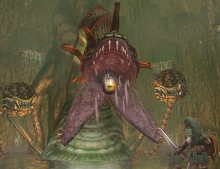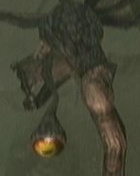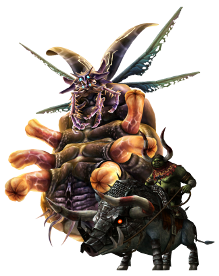Zelda Bosses: The Bigger They Are The Harder They Fall?
Posted on September 24 2010 by Axle D. Wilder
 You’ve just journeyed through a difficult dungeon, exploring every nook and cranny and fighting evil monsters along the way. You’ve spent your time battling fierce opponents and solving puzzles, and you’ve finally gotten the Big Key. You open the final door. Then something big appears. Something really big. Real FRICKEN’ big! You prepare for an intense fight against the big boss and whip out the weapon you found in the dungeon. Three blows into the battle…
You’ve just journeyed through a difficult dungeon, exploring every nook and cranny and fighting evil monsters along the way. You’ve spent your time battling fierce opponents and solving puzzles, and you’ve finally gotten the Big Key. You open the final door. Then something big appears. Something really big. Real FRICKEN’ big! You prepare for an intense fight against the big boss and whip out the weapon you found in the dungeon. Three blows into the battle…
He’s dead. Wow, really?
In a video game, what is a boss? Is it a bigger, badder enemy? Is it a spike in challenge? Is it the climax to a portion of the game? It’s all of these things. Bosses are designed to be tougher foes who are harder to fight, and are often placed at the end of a major part of the game. They are designed, more or less, as transitions; a way to end a normal section of the game with a bang. Without a boss to face or some other kind of set piece, it’s unappealing when you transition from one part of the game to another. Something has to move you through that transition. But a boss is a bigger enemy right? So shouldn’t it be a harder one?
 Many Zelda games these days have significantly limited the bosses. They are now easy foes, with simple to deduce methods for killing them and predictable designs. In The Wind Waker and Twilight Princess, there was always some kind of titanic monster at the end of the dungeon. There was no reason to suspect anything else. But the bigger they are, the harder they fall, and it seems with Zelda that the larger and fiercer the bosses become, the less of a challenge they pose. It’s one thing when the boss is roughly the same difficulty as the rest of the enemies in the game, but it’s ENTIRELY ANOTHER when the boss is EASIER than normal enemies and challenges. This has been the case with most bosses in the last two console titles, and there’s no excuse for it.
Many Zelda games these days have significantly limited the bosses. They are now easy foes, with simple to deduce methods for killing them and predictable designs. In The Wind Waker and Twilight Princess, there was always some kind of titanic monster at the end of the dungeon. There was no reason to suspect anything else. But the bigger they are, the harder they fall, and it seems with Zelda that the larger and fiercer the bosses become, the less of a challenge they pose. It’s one thing when the boss is roughly the same difficulty as the rest of the enemies in the game, but it’s ENTIRELY ANOTHER when the boss is EASIER than normal enemies and challenges. This has been the case with most bosses in the last two console titles, and there’s no excuse for it.
I believe that one of the biggest issues lies with how limited the bosses have become. Rules for Zelda bosses in modern day? They’re gigantic, encountered at the end of a dungeon, and weak against that dungeon’s weapon. When a game developer follows the same basic formula for 4+ games, their creativity can become stunted and the methods used to defeat a boss become predictable; they begin to lack variety, which is one key trait that a boss is supposed to have. It’s not impossible for Nintendo to come up with new ideas for good bosses in the current environment, but even if they do they’ll still be limited in creativity.
One major issue for current bosses is the size. Remember A Link to the Past? Plenty of the bosses were not much above Link’s size. Plenty others were larger, but still not over the size of a building. Why would you possibly want to limit the foes to ones that are gigantic when you can take advantage of far more creativity with smaller bosses? Dark Link has consistently been a very challenging boss who mimicked Link’s moveset and fought on nearly equal footing. By reducing their size and no longer limiting them, the bosses will become much more unique. When fewer bosses are large, bigger bosses will be more memorable. At this point, the height doesn’t even impress us anymore. It was cool at first, but it’s been overdone; there’s no good reason for every single boss to tower over you.

Hey, look, another boss taller than a building. And guess how it attacks? Breathing fire and smashing things.
Similar points could be made about requiring the dungeon item to beat the boss you find in the same dungeon. Requiring a single item acquired in that dungeon has several issues. First, it limits the boss’s uniqueness as he has to completely revolve around one item. Secondly, it makes the boss childishly easy to figure out most of the time. What about finding a dungeon item but using a different item to defeat the boss, or several items? The point is, following strict rules such as these holds back the boss in almost every way. More unique approaches should be taken so the bosses can thrive. This is an issue that dates back before the last two games, though. When this mechanic was first introduced, it felt fresh because the puzzle element was more prominent in boss fights than ever before. But now we’re used to it and it no longer holds any surprises for us. It’s time to move on.
 A lot of this has to do with dungeons. But there’s another element to be considered in such a game. Why do bosses need to be restricted to dungeons? Granted, we’ve seen mini-bosses like King Bulblin and Bloat outside of dungeons in Twilight Princess; that’s a step in the right direction. If a boss is to provide an epic transition, why should those transitions only exist within dungeons? Major transitions and bosses in the field could enhance game design, side material, and story. A game in which the field and dungeons flowed naturally from each other, rather than being as obviously separated as they have been in older Zelda titles, would offer an opportunity to enrich both the bosses and the game in general.
A lot of this has to do with dungeons. But there’s another element to be considered in such a game. Why do bosses need to be restricted to dungeons? Granted, we’ve seen mini-bosses like King Bulblin and Bloat outside of dungeons in Twilight Princess; that’s a step in the right direction. If a boss is to provide an epic transition, why should those transitions only exist within dungeons? Major transitions and bosses in the field could enhance game design, side material, and story. A game in which the field and dungeons flowed naturally from each other, rather than being as obviously separated as they have been in older Zelda titles, would offer an opportunity to enrich both the bosses and the game in general.
I also feel a boss battle should be just that: A battle. While the puzzle element to the boss fights is incredible when implemented correctly, the fight should not rely on it entirely and revealing the weak point should not make the rest of the battle easy. Even if Nintendo intends to keep the Zelda series easy so it’s accessible to all gamers, there’s not a lot of sense in having larger, scarier enemies that don’t pose any additional challenge; if each dungeon boss is fiercer than the rabble fought throughout the rest of the game, then the boss fights should be designed accordingly. The game can still be accessible while making the bosses harder than the normal enemies. This will not alienate casual gamers, since the boss merely needs to be more difficult in comparison to the rest of the game.
Boss battles, when implemented correctly, help a game flow more smoothly. Without them, the game feels dull. Set pieces like these are important and should not be restricted by silly tradition, and indeed, expanding what we consider a “boss” in this way will lead to many more unique boss battles. I’m all for the traditional approach, but not if it holds back the bosses from being good and keeping the game moving. In order for boss battles to become a strength rather than a weakness, certain changes must be made to the fundamentals.



